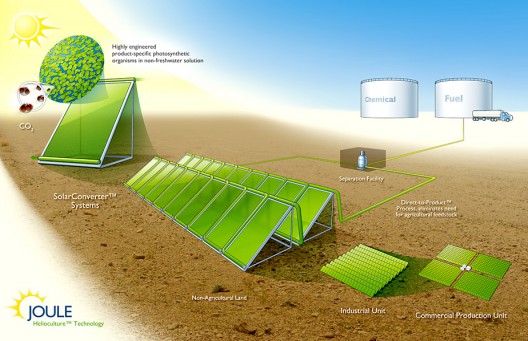Their web site has more registered trademarks than Burger King*, including Liquid Fuel from the Sun™, Helioculture™, SolarConverter™, and direct-to-end-product™.
Joule’s technology promises Diesel or ethanol liquid fuels in huge amounts, using “proprietary organisms” to directly convert CO2 struck by sunlight into replacements for existing fossil fuels. According to Joule, “Our technology has already been proven with the direct conversion of CO2 to liquid hydrocarbons and ethanol, avoiding the economic and environmental burden of multi-step, petroleum- or biomass-dependent methods.” Claiming “commercial-ready” status, Joule says its interconnected components are “scalable and customizable to any desired output levels based on land and CO2 availability.”
Promoting an “ecologically smart method,” “Joule’s production process avoids the depletion of precious natural resources, with no dependency on agricultural land, crops or fresh water. At the same time, an independently-conducted lifecycle analysis shows that, through our intake of waste CO2, we have the potential to reduce harmful carbon emissions on a large scale – up to 90% in some instances.” Organisms used in the system are designed to work only in the closed system, with their inadvertent release into the outside environment leading to their swift and harmless (to other living things) demise.
George Church’s background as creator of the first direct genomic sequencing method, innovations in DNA reading, and other highly complex studies lends credibility to the organization and its rather incredible goals, including production of up to 15,000 gallons of Diesel fuel or 25,000 gallons of ethanol per year per acre. If production did achieve the 50X efficiencies of biofuel production and lead to $30 per barrel fuel, we might see a return to $1.50 per gallon gasoline.
As always, exercise caution in evaluating such ventures. Your mileage may vary.
*The hamburger chain actually registered “Have it your way,” taking a long-time argument-ender out of the public domain.


Comments 1
I do believe strongly in this algal technology as being a corner stone of our future energy “parcel” of solutions. Some years ago when I first learnt more about the potential yields from algae I began looking for ways to harvest algae at the micro level, and the final solution at the time was what I called the algal fence line. This I saw as being the most practical location for a backyard algal farm. But it quickly became obvious that by far the largest hurdle with algal farming apart from the nutrients is in sourcing CO2 for the algae to feed on. The problem is that CO2 has just a .039% presence in the air. It is actually not that plentiful, and amazing that such a small concentration has such huge leverage on our climate. So how do you capture CO2 from air without expending large amounts of energy doing it. I’ve since conceived a workable solution using some elements of Klaus Lackner’s ideas in a very different form. The next challenge is to design a compact benchtop all in one algae to oil processor. So I see a lot of similarities in the Joule Unlimited illustration above, and it has merit, I believe, particularly if high yield algae are available in a way that will not harm the environment.
The floods and cyclones in Australia though should serve as a warning that land based bio fuel production has severe pitfalls. The wiping out of sugarcane crops in Queensland demonstrates the vulnerability that reliance crops to fuel can have.
This is why I believe that NASA’s Omega project is the primary solution for our future bulk biofuel needs. This system is by far the most robust solution under development today. That is not to say that the thousands of other solutions are not important, they are every bit as much, but Omega has the ultimate scaleability with the least vulnerabilities.